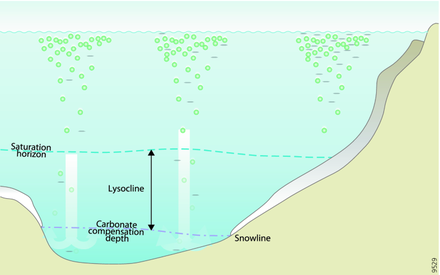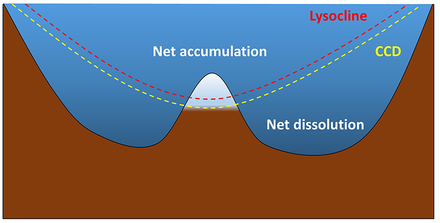Carbonate compensation depth
The carbonate compensation depth (CCD) is the depth, in the oceans, at which the rate of supply of calcium carbonates matches the rate of solvation. That is, solvation 'compensates' supply. Below the CCD solvation is faster, so that carbonate particles dissolve and the carbonate shells (tests) of animals are not preserved. Carbonate particles cannot accumulate in the sediments where the sea floor is below this depth.
Calcite is the least soluble of these carbonates, so the CCD is normally the compensation depth for calcite. The aragonite compensation depth (ACD) is the compensation depth for aragonitic carbonates. Aragonite is more soluble than calcite, and the aragonite compensation depth is generally shallower than both the calcite compensation depth and the CCD.
Overview


As shown in the diagram, biogenic calcium carbonate (CaCO3) tests are produced in the photic zone of the oceans (green circles). Upon death, those tests escaping dissolution near the surface settle, along with clay materials. In seawater, a dissolution boundary is formed as a result of temperature, pressure, and depth, and is known as the saturation horizon.[3] Above this horizon, waters are supersaturated and CaCO3 tests are largely preserved. Below it, waters are undersaturated, because of both the increasing solubility with depth and the release of CO2 from organic matter decay, and CaCO3 will dissolve. The sinking velocity of debris is rapid (broad pale arrows), so dissolution occurs primarily at the sediment surface.
At the carbonate compensation depth, the rate of dissolution exactly matches the rate of supply of CaCO3 from above. At steady state this depth, the CCD, is similar to the snowline (the first depth where carbonate-poor sediments occur). The lysocline is the depth interval between the saturation and carbonate compensation depths.[4][1]
Solubility of carbonate
Calcium carbonate is essentially insoluble in sea surface waters today. Shells of dead calcareous plankton sinking to deeper waters are practically unaltered until reaching the lysocline, the point about 3.5 km deep past which the solubility increases dramatically with depth and pressure. By the time the CCD is reached[clarification needed] all calcium carbonate has dissolved according to this equation:
Calcareous plankton and
Variations in value of the CCD
| Part of a series on the |
| Carbon cycle |
|---|
 |
The exact value of the CCD depends on the solubility of calcium carbonate which is determined by temperature, pressure and the chemical composition of the water – in particular the amount of dissolved CO2 in the water. Calcium carbonate is more soluble at lower temperatures and at higher pressures. It is also more soluble if the concentration of dissolved CO2 is higher. Adding a reactant to the above chemical equation pushes the equilibrium towards the right producing more products: Ca2+ and HCO3−, and consuming more reactants CO2 and calcium carbonate according to Le Chatelier's principle.
At the present time the CCD in the
In the
John Murray investigated and experimented on the dissolution of calcium carbonate and was first to identify the carbonate compensation depth in oceans.[7]
Climate change impacts
Increasing
Sedimentary ooze
On the
See also
- Carbonate pump
- Great Calcite Belt
- Lysocline
- Ocean acidification
References
- ^ S2CID 104368944..
 Modified material was copied from this source, which is available under a Creative Commons Attribution 4.0 International License
Modified material was copied from this source, which is available under a Creative Commons Attribution 4.0 International License - ^ Webb, Paul (2019) Introduction to Oceanography, Chapter 12: Ocean Sediments, page 273–297, Rebus Community. Updated 2020.
 Modified text was copied from this source, which is available under a Creative Commons Attribution 4.0 International License.
Modified text was copied from this source, which is available under a Creative Commons Attribution 4.0 International License.
- ^ "Ocean acidification due to increasing atmospheric carbon dioxide". The Royal Society.
- S2CID 135284130.
- ^ Thurman, Harold., Alan Trujillo. Introductory Oceanography.2004.p151-152
- ^ "Warmer than a Hot Tub: Atlantic Ocean Temperatures Much Higher in the Past". Physorg.com. February 17, 2006.
- ISBN 978-94-007-6238-1.
- PMID 30373837.
- S2CID 53062358.
- ISSN 0025-3227.
- ^ Webb, Paul. "12.6 Sediment Distribution".
{{cite journal}}: Cite journal requires|journal=(help)

